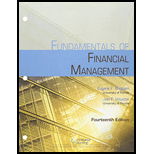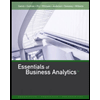
Bundle: Fundamentals of Financial Management, 14th + MindTap Finance, 1 term (6 months) Printed Access Card
14th Edition
ISBN: 9781305777118
Author: Eugene F. Brigham, Joel F. Houston
Publisher: Cengage Learning
expand_more
expand_more
format_list_bulleted
Question
Chapter 6, Problem 1P
a.
Summary Introduction
To prepare: The yield curve.
Yield Curve: The graphical representation of expected return, provided by the company to its investors during the years is known as yield curve. It is used to summarize and present the trend in expected returns.
b.
Summary Introduction
To identify: The type of yield curve of given data.
Normal Yield Curve:
A yield curve, which shows the low yield for the short-term bonds and high yield for the long-term debt is known as normal yield curve.
c.
Summary Introduction
To identify: The analysis derived from the graph.
d.
Summary Introduction
To identify: The better option to borrow money for longer than 1 year.
Expert Solution & Answer
Trending nowThis is a popular solution!

Students have asked these similar questions
$1.35 Million for the below question is incorrect, Machine A is $1.81 and Machine B is $0.46 Million.
The Perez Company has the opportunity to invest in one of two mutually exclusive machines that will produce a product it will need for the foreseeable future. Machine A costs $8 million but realizes after-tax inflows of $4.5 million per year for 4 years. After 4 years, the machine must be replaced. Machine B costs $17 million and realizes after-tax inflows of $4 million per year for 8 years, after which it must be replaced. Assume that machine prices are not expected to rise because inflation will be offset by cheaper components used in the machines. The cost of capital is 13%. Using the replacement chain approach to project analysis, by how much would the value of the company increase if it accepted the better machine? Round your answer to two decimal places.
1.) $1.35 million
Buggies-Are-Us
Steady Freddie, Inc
Gang Buster Group
g = 0
g =
55%
Year 1
$3.51
(i.e., dividends
are expected
to remain at
$3.053.05/share)
(for the
foreseeable
future)
Year 2
$4.04
Year 3
$4.63
Year 4
$5.36
Year 5
$6.15
Year 6 and beyond: g =
55%
Project S has a cost of $10,000 and is expected to produce benefits (cash flows) of $3,000 per year for 5 years. Project L costs $25,000 and is expected to produce cash flows of $7,400 per year for 5 years.
Calculate the two projects' NPVs, assuming a cost of capital of 12%. Do not round intermediate calculations. Round your answers to the nearest cent.
Calculate the two projects' PIs, assuming a cost of capital of 12%. Do not round intermediate calculations. Round your answers to three decimal places.
Project L is not 1.07
Chapter 6 Solutions
Bundle: Fundamentals of Financial Management, 14th + MindTap Finance, 1 term (6 months) Printed Access Card
Ch. 6 - Prob. 1QCh. 6 - Prob. 2QCh. 6 - Suppose you believe that the economy is just...Ch. 6 - Prob. 4QCh. 6 - Suppose a new process was developed that could be...Ch. 6 - Prob. 6QCh. 6 - Prob. 7QCh. 6 - Suppose interest rates on Treasury bonds rose from...Ch. 6 - Prob. 9QCh. 6 - Suppose you have noticed that the slope of the...
Ch. 6 - Prob. 1PCh. 6 - REAL RISK-FREE RATE You read in The Wall Street...Ch. 6 - EXPECTED INTEREST RATE The real risk-free rale is...Ch. 6 - DEFAULT RISK PREMIUM A Treasury bond that matures...Ch. 6 - MATURITY RISK PREMIUM The real risk-free rate is...Ch. 6 - INFLATION CROSS-PRODUCT An analyst is evaluating...Ch. 6 - EXPECTATIONS THEORY One-year Treasury securities...Ch. 6 - Prob. 8PCh. 6 - Prob. 9PCh. 6 - Prob. 10PCh. 6 - Prob. 11PCh. 6 - MATURITY RISK PREMIUM An investor in Treasury...Ch. 6 - Prob. 13PCh. 6 - EXPECTATIONS THEORY AND INFLATION Suppose 2-year...Ch. 6 - EXPECTATIONS THEORY Assume that the real risk-free...Ch. 6 - Prob. 16PCh. 6 - Prob. 17PCh. 6 - Prob. 18PCh. 6 - Prob. 19PCh. 6 - INTEREST RATE DETERMINATION AND YIELD CURVES a....Ch. 6 - Prob. 21IC
Knowledge Booster
Similar questions
- Wilbur and Orville are brothers. They're both serious investors, but they have different approaches to valuing stocks. Wilbur, the older brother, likes to use the dividend valuation model. Orville prefers the free cash flow to equity valuation model. As it turns out, right now, both of them are looking at the same stock-Wright First Aerodynmaics, Inc. (WFA). The company has been listed on the NYSE for over 50 years and is widely regarded as a mature, rock-solid, dividend-paying stock. The brothers have gathered the following information about WFA's stock: Current dividend (D) = $2.30/share Current free cash flow (FCF) = $1.5 million Expected growth rate of dividends and cash flows (g) = 5% Required rate of return (r) = 14% Shares outstanding 500,000 shares How would Wilbur and Orville each value this stock?arrow_forwardCompany P/S Multiples Facebook 13.33 Snap 18.22 Twitter 13.27arrow_forwardThe Perez Company has the opportunity to invest in one of two mutually exclusive machines that will produce a product it will need for the foreseeable future. Machine A costs $8 million but realizes after-tax inflows of $4.5 million per year for 4 years. After 4 years, the machine must be replaced. Machine B costs $17 million and realizes after-tax inflows of $4 million per year for 8 years, after which it must be replaced. Assume that machine prices are not expected to rise because inflation will be offset by cheaper components used in the machines. The cost of capital is 13%. Using the replacement chain approach to project analysis, by how much would the value of the company increase if it accepted the better machine? Round your answer to two decimal places. 1.) $ millionarrow_forward
- Wilbur and Orville are brothers. They're both serious investors, but they have different approaches to valuing stocks. Wilbur, the older brother, likes to use the dividend valuation model. Orville prefers the free cash flow to equity valuation model. As it turns out, right now, both of them are looking at the same stock-Wright First Aerodynmaics, Inc. (WFA). The company has been listed on the NYSE for over 50 years and is widely regarded as a mature, rock-solid, dividend-paying stock. The brothers have gathered the following information about WFA's stock: Current dividend (D) = $3.30/share Current free cash flow (FCF) = $1.5 million Expected growth rate of dividends and cash flows (g)=8% Required rate of return (r) = 13% Shares outstanding 500,000 shares How would Wilbur and Orville each value this stock? The stock price from Wilbur's valuation is $ (Round to the nearest cent.)arrow_forwardThe Perez Company has the opportunity to invest in one of two mutually exclusive machines that will produce a product it will need for the foreseeable future. Machine A costs $8 million but realizes after-tax inflows of $4.5 million per year for 4 years. After 4 years, the machine must be replaced. Machine B costs $17 million and realizes after-tax inflows of $4 million per year for 8 years, after which it must be replaced. Assume that machine prices are not expected to rise because inflation will be offset by cheaper components used in the machines. The cost of capital is 13%. Using the replacement chain approach to project analysis, by how much would the value of the company increase if it accepted the better machine? Round your answer to two decimal places. 1.) $ million What is the equivalent annual annuity for each machine? Do not round intermediate calculations. Round your answers to two decimal places. 2.) Machine A: $ million 3.) Machine B: $ millionarrow_forwardYou expect to have $29,865. You plan to make X savings contribution of $1,690 per month. The expected return is 0.92 percent per month and the first regular savings contribution will be made later today. What is X? Round to 2 decimal places.arrow_forward
- Company P/S Multiples Facebook 13.67 Snap 18.76 Twitter 13.55arrow_forwardEnergy Resources generated an EPS of $4.38 over the last 12 months. The company's earnings are expected to grow by 30.7% next year, and because there will be no significant change in the number of shares outstanding, EPS should grow at about the same rate. You feel the stock should trade at a P/E of around 30 times earnings. Use the P/E approach to set a value on this stock. Using the P/E approach, the value on this stock is $ (Round to the nearest cent.)arrow_forwardThe Anderson Company has a net profits of $20 million, sales of $226 million, and 3.9 million shares of common stock outstanding. The company has total assets of $139 million and total stockholders' equity of $74 million. It pays $2.31 per share in common dividends, and the stock trades at $40 per share. Given this information, determine the following: a. Anderson's EPS. b. Anderson's book value per share and price-to-book-value ratio. c. The firm's P/E ratio. d. The company's net profit margin. e. The stock's dividend payout ratio and its dividend yield. f. The stock's PEG ratio, given that the company's earnings have been growing at an average annual rate of 8.2%. a. Anderson's EPS is $ (Round to the nearest cent.)arrow_forward
- Davis Industries must choose between a gas-powered and an electric-powered forklift truck for moving materials in its factory. Because both forklifts perform the same function, the firm will choose only one. (They are mutually exclusive investments.) The electric-powered truck will cost more, but it will be less expensive to operate; it will cost $23,000, whereas the gas-powered truck will cost $17,100. The cost of capital that applies to both investments is 11%. The life for both types of truck is estimated to be 6 years, during which time the net cash flows for the electric-powered truck will be $6,500 per year, and those for the gas-powered truck will be $4,750 per year. Annual net cash flows include depreciation expenses. Calculate the NPV and IRR for each type of truck, and decide which to recommend. Do not round intermediate calculations. Round the monetary values to the nearest dollar and percentage values to two decimal places. Electric-poweredforklift truck…arrow_forwardA project has an initial cost of $45,000, expected net cash inflows of $9,000 per year for 11 years, and a cost of capital of 14%. What is the project's NPV? (Hint: Begin by constructing a time line.) Do not round intermediate calculations. Round your answer to the nearest cent.arrow_forwardA project has an initial cost of $45,000, expected net cash inflows of $9,000 per year for 11 years, and a cost of capital of 14%. What is the project's NPV? (Hint: Begin by constructing a time line.) Do not round intermediate calculations. Round your answer to the nearest cent.arrow_forward
arrow_back_ios
SEE MORE QUESTIONS
arrow_forward_ios
Recommended textbooks for you
 Intermediate Financial Management (MindTap Course...FinanceISBN:9781337395083Author:Eugene F. Brigham, Phillip R. DavesPublisher:Cengage Learning
Intermediate Financial Management (MindTap Course...FinanceISBN:9781337395083Author:Eugene F. Brigham, Phillip R. DavesPublisher:Cengage Learning Essentials of Business Analytics (MindTap Course ...StatisticsISBN:9781305627734Author:Jeffrey D. Camm, James J. Cochran, Michael J. Fry, Jeffrey W. Ohlmann, David R. AndersonPublisher:Cengage Learning
Essentials of Business Analytics (MindTap Course ...StatisticsISBN:9781305627734Author:Jeffrey D. Camm, James J. Cochran, Michael J. Fry, Jeffrey W. Ohlmann, David R. AndersonPublisher:Cengage Learning


Intermediate Financial Management (MindTap Course...
Finance
ISBN:9781337395083
Author:Eugene F. Brigham, Phillip R. Daves
Publisher:Cengage Learning

Essentials of Business Analytics (MindTap Course ...
Statistics
ISBN:9781305627734
Author:Jeffrey D. Camm, James J. Cochran, Michael J. Fry, Jeffrey W. Ohlmann, David R. Anderson
Publisher:Cengage Learning